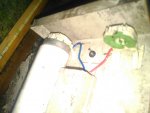You are using an out of date browser. It may not display this or other websites correctly.
You should upgrade or use an alternative browser.
You should upgrade or use an alternative browser.
Removing a Lamp
- Thread starter Trey4U
- Start date
- Status
- Not open for further replies.
kwired
Electron manager
- Location
- NE Nebraska
- Occupation
- EC
I don't think so.
There are some designs that put two lamps in series, in those cases you interrupt the circuit for both lamps when you remove one lamp. Other cases the lamps are in parallel to one another, all you are doing is taking that one lamp out of the circuit while the other continues to operate.
There are some designs that put two lamps in series, in those cases you interrupt the circuit for both lamps when you remove one lamp. Other cases the lamps are in parallel to one another, all you are doing is taking that one lamp out of the circuit while the other continues to operate.
Knuckle Dragger
Master Electrician Electrical Contractor 01752
- Location
- Marlborough, Massachusetts USA
- Occupation
- Electrical Contractor
If I remember correctly the magnetic bi bins typically needed two lamps to function properly.
The eight foot single push-in's fed the beauty through on of the pins.
The electronic ballasts seem to function okay with one lamp.
The eight foot single push-in's fed the beauty through on of the pins.
The electronic ballasts seem to function okay with one lamp.
We have a mix of magnetic and electronic ballasts in different buildings here and I was told that the ballast can be damaged if you remove one lamp. I don't believe this but figured I'd ask the experts here. Thanks for the info.
kwired
Electron manager
- Location
- NE Nebraska
- Occupation
- EC
Because both those you mentioned have series connections involved through the lamp. Take the lamp out and you break the entire circuit and remaining installed lamp won't function.If I remember correctly the magnetic bi bins typically needed two lamps to function properly.
The eight foot single push-in's fed the beauty through on of the pins.
The electronic ballasts seem to function okay with one lamp.
When electronic ballasts came into play, some don't use any series connections, even for same lamp type, some do.
Most T8 lamp types AFAIK were all parallel connected. You can remove any one lamp and the rest still function. You could use a 4 lamp ballast as a replacement for a 3 lamp fixture and just cap leads for the 4th lamp and it worked fine.
PaulMmn
Senior Member
- Location
- Union, KY, USA
- Occupation
- EIT - Engineer in Training, Lafayette College
Where I work we have 4' fluorescent tube fixtures all across the ceiling. It is/was common practice to remove at least 1 of the tubes due to the OSHA 'recommended desktop illumination' (one of the early editions) being nearly solar-bright. A much lower level of light was more comfortable to those of us working longer hours. We never had issues with the remaining bulbs. And were able to return the 'extra' bulbs to the maintenance crew.
Right now, the fixture closest to my desk has 3 out of 4 lamp positions occupied.
re: OSHA recommended desktop illumination- At one point they cut back the recommended levels to something more comfortable, with task lighting where-needed. I don't think I've used my 'task lighting' more than a few minutes, and that to hold up 2 diagrams to the light to compare them!
Right now, the fixture closest to my desk has 3 out of 4 lamp positions occupied.
re: OSHA recommended desktop illumination- At one point they cut back the recommended levels to something more comfortable, with task lighting where-needed. I don't think I've used my 'task lighting' more than a few minutes, and that to hold up 2 diagrams to the light to compare them!
All you are doing is removing that one light from the circuit while the different keeps on working.so it doesn't damage ballastand in different cases the lights are in corresponding to each other
I have a question about removing a lamp from a two lamp fixture. Does removing one fluorescent lamp from a two lamp fixture damage the ballast? Magnetic or electronic.
I was investigating the cause of a arcing fault fire started by a fluorescent fixture last year in a 80YO lady's house. I might have made a post on here about it. I traced it back to the 'series' side of the lamps. One of the tomb stones must have gotten to hot or the ballast must have been firing a start up pulse thru weak connection until plastic melted and combustion started.Because both those you mentioned have series connections involved through the lamp. Take the lamp out and you break the entire circuit and remaining installed lamp won't function.
When electronic ballasts came into play, some don't use any series connections, even for same lamp type, some do.
Most T8 lamp types AFAIK were all parallel connected. You can remove any one lamp and the rest still function. You could use a 4 lamp ballast as a replacement for a 3 lamp fixture and just cap leads for the 4th lamp and it worked fine.
The ballast was undamaged and the 15A breaker was intact tested OK and did not trip. Fixtures ECG was connected and tested OK.
I had never seen that wiring configuration before, but it seem like a bad idea. I usually see a 'yellow' lead go from the ballast to that end.


- Status
- Not open for further replies.

